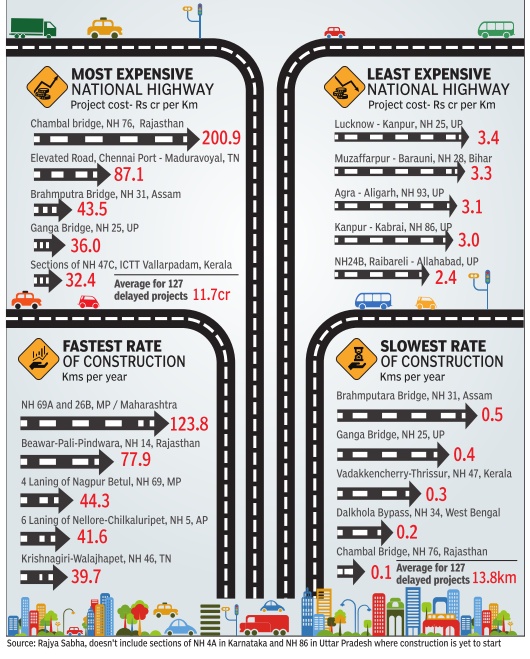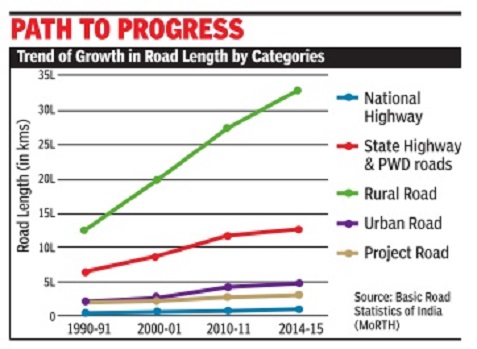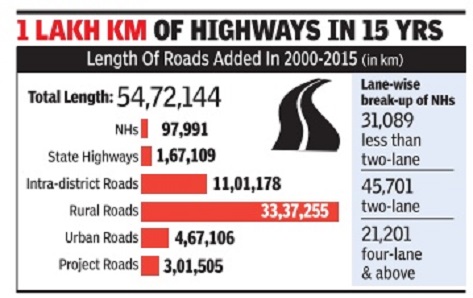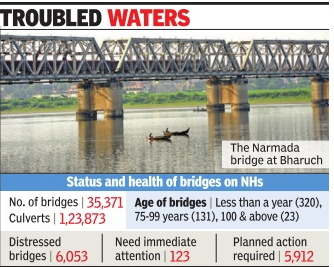National Highways: India
(→2015-16: Record construction) |
(→Factoids about National Highways) |
||
| (12 intermediate revisions by one user not shown) | |||
| Line 7: | Line 7: | ||
|} | |} | ||
| − | |||
| − | |||
| − | |||
| − | |||
| + | |||
| + | |||
| + | |||
| + | |||
| + | |||
| + | =Accident prone highways= | ||
| + | ==As in 2021== | ||
| + | [https://timesofindia.indiatimes.com/india/danger-ahead-why-you-need-to-be-careful-on-these-highways/articleshow/82854809.cms Kanishk Sharma, May 30, 2021: ''The Times of India''] | ||
| + | |||
| + | [[File: Some details about road accidents and death on NHs and SHs, 2019.jpg|Some details about road accidents and death on NHs and SHs, 2019 <br/> From: [https://timesofindia.indiatimes.com/india/danger-ahead-why-you-need-to-be-careful-on-these-highways/articleshow/82854809.cms Kanishk Sharma, May 30, 2021: ''The Times of India'']|frame|500px]] | ||
| + | |||
| + | |||
| + | |||
| + | ''' India tops the world in road crash deaths. A look at some of the dangerous stretches and why our highways are death traps ''' | ||
| + | |||
| + | * May 5, 2021: Vivek Sharma (name changed) and his wife had a narrow escape when their car hit a nilgai on National Highway (NH)509 near Silhari in Badaun district, Uttar Pradesh | ||
| + | |||
| + | * December 27, 2020: Narayan Beniwal, an MLA from Nagaur district in Rajasthan, suffered serious injuries after his SUV collided with a pickup vehicle near Shahjahanpur on Delhi-Jaipur highway (NH8) | ||
| + | |||
| + | * January 30, 2019: Singer-cum-stage performer Shivani Bhatia was killed when her husband Nikhil lost control of the vehicle on Yamuna Expressway in Mathura district | ||
| + | |||
| + | These three incidents are not even the tip of the iceberg. India reported 92,837 deaths in 2,35,929 road accidents on national and state highways in 2019, according to the Ministry of Road Transport and Highways. This amounts to a fatality rate of around 39.34%. | ||
| + | |||
| + | The World Bank has come out with more damning statistics. In its 2019 report ‘Guide for Road Safety Opportunities and Challenges: Low- and Middle-Income Countries Country Profile’, it says: “India tops the world in road crash deaths and injuries. It has 1% of the world’s vehicles but accounts for 11% of all road crash deaths, witnessing 53 road crashes every hour; killing one person every four minutes.” | ||
| + | |||
| + | India’s road ministry has identified many spots which have witnessed a high number of accidents and deaths. Here’s a list of the most dangerous highway stretches with the highest number of accidents and fatalities: | ||
| + | |||
| + | '' Chennai–Thiruvallur High Road ''
| ||
| + | The 500-metre black spot stretch on Chennai-Thiruvallur High Road between Mannurpet and AMBT Telephone Exchange in Chennai, Tamil Nadu, on NH205 is on the top of the list with the most number of accidents and fatalities between 2016 and 2018. | ||
| + | |||
| + | According to a National Highway Authority of India (NHAI) data, the stretch has seen 775 accidents and 166 fatalities in three years. | ||
| + | |||
| + | '' NH37 in Assam ''
| ||
| + | NH37 connecting Manipur and Assam has a little known stretch between Garchuk and NP School in Guwahati. According to NHAI data, this stretch of the national highway has seen comparatively fewer number of accidents but the fatality count is much higher than other highway stretches. The spot has witnessed just 193 accidents, but a significant 104 deaths between 2016 and 2018. | ||
| + | |||
| + | Three more black spots on the same highway have been marked as dangerous for motorists. The Boragaon to Garchuk stretch saw 81 fatalities in 163 accidents while Baligate-Kapalkata-Samata block saw 76 deaths in 157 mishaps. | ||
| + | |||
| + | Beharbari Chariali to Lalmati stretch witnessed 186 crashes and 64 fatalities. | ||
| + | |||
| + | '' Nazarathpet junction on Bangalore-Chennai Road ''
| ||
| + | The Nazarathpet junction on the Bengaluru-Chennai Road on NH44 in Tamil Nadu’s capital is not far behind in terms of accidents and fatalities. This 500-metre stretch has witnessed 520 crashes and 96 deaths between 2016 and 2018, according to NHAI. | ||
| + | |||
| + | '' Tambaram-Puzhal Bypass Road near Porur toll gate, Chennai ''
| ||
| + | Chennai again features on this list of most deadly black spot stretches on national highways in the country. The Tambaram-Puzhal Bypass Road has witnessed fewer accidents than Nazarathpet junction at 423, but more deaths in three years (97). | ||
| + | |||
| + | '' Purva Road on NH25 in Uttar Pradesh ''
| ||
| + | A stretch in Uttar Pradesh makes it to the list with a fatality rate of 89.61% and has been marked as dangerous. A black spot on Purva Road on NH25 in Unnao district has witnessed 77 accidents and 69 deaths between 2016 and 2018. | ||
| + | |||
| + | '' Govt JR College Centre, RTC Ingate in Andhra Pradesh ''
| ||
| + | This stretch in Andhra Pradesh’s East Godavari district has seen 38 mishaps and 50 deaths between 2016 and 2018 with a fatality rate at 131%. | ||
| + | |||
| + | '' Karanpur Pahadee on NH7 in Uttar Pradesh ''
| ||
| + | As many as 55 people have lost their lives in 74 accidents on a black spot in Karanpur Pahadee area on NH7 in Uttar Pradesh’s Mirzapur district between 2016 and 2018, according to NHAI data. | ||
| + | |||
| + | ''' So, what is a black spot? '''
| ||
| + | A black spot is a road corridor of about 500 metres on which five road accidents involving fatalities and serious injuries, or 10 road fatalities, have been reported during the last three years. | ||
| + | |||
| + | Tamil Nadu has the most number of black spots at 748 followed by West Bengal (701), Karnataka (551), Telangana (485) and Andhra Pradesh (466). | ||
| + | |||
| + | ''' Highways to hell '''
| ||
| + | Recently, the International Road Federation (IRF), a Geneva-based body, wrote to Union Minister for Road Transport and Highways Nitin Gadkari urging him to circulate the scientific guidelines developed by the Indian Road Congress (IRC) to identify and treat black spots in the country. | ||
| + | |||
| + | In his letter to Gadkari, IRF’s president emeritus KK Kapila said that all counter-measures – short term, medium term and long term – adopted by the field officers assigned to remove black spots are totally ad hoc without any basis of scientific investigation across the country. | ||
| + | |||
| + | “The black spot programme of the government has been going on since 2015, when the first list of black spots was issued by the ministry, and after six years, we have still not been able to make a difference in the country’s road safety outcome in terms of number of accidents/road crashes recorded year on year. One reason perhaps is the ad hoc approach of tackling the blackspots. Lot of efforts and resources were expended without deriving commensurate benefits,” said Kapila. | ||
| + | |||
| + | ''' Blame it on black spots ‘''
| ||
| + | “To blame only black spots for the accidents and related deaths is not the correct way to address the real issue,” says Rohit Baluja, director of Institute of Road Traffic Education and College of Traffic Management, Faridabad. | ||
| + | |||
| + | He goes on to say “poor traffic engineering and almost negligible enforcement are amongst the important reasons for highway crashes”. | ||
| + | Baluja says: “Vulnerable road users are not given importance. Higher speeds, design failures and negligence of concessionaires and engineering agencies have to share the blame.” | ||
| + | |||
| + | ''' Why are Indian highways unsafe? '''
| ||
| + | “Indian highways are unsafe due to mixed traffic conditions. High-speed motor vehicles, unsafe road infrastructure and pedestrian movements contribute to the high accident rate,” says Amar Srivastava, an IIT alumnus, who heads the country’s biggest student-led road safety organisation, Indian Road Safety Campaign. | ||
| + | |||
| + | “Major accidents result in fatalities due to inadequate emergency trauma care facilities and delayed response time. Moreover, the rapidly growing number of vehicles, bad driving skills and weak enforcement of law add to the problem,” he says. | ||
| + | |||
| + | Geetam Tiwari of the Indian Institute of Technology, Delhi and an expert on transport planning and engineering says non-availability of designs for mixed traffic conditions, poor implementation of known design standards for motorised traffic like incorrect safety barriers, wrong median designs make our highways unsafe. | ||
| + | |||
| + | “Also, traffic and crash patterns are substantially different in India. Therefore, highway design standards that are applicable in the US or UK may not have the same level of effectiveness in ensuring safe movement of traffic in low-to-middle-income countries like ours,” she says. | ||
| + | |||
| + | Highways in India generally cater to mixed vehicular population with varying speeds. Drive down an Indian highway and you’ll notice trucks, cars, two wheelers and non-motorised vehicles, including bicycles, camel and bullock carts jostling for space. | ||
| + | |||
| + | The presence of pedestrians from nearby rural areas adds to the problem, says Neha Khullar, director (projects) of Muskaan, a Rajasthan-based non-profit which works on road safety. | ||
| + | |||
| + | “Also, most accidents happen either at crossroads where the highway is passing through a habitat or on straight roads where there are no facilities for speed management,” she says. | ||
| + | |||
| + | “NHAI develops and invests in highways, which bring economic advantage and prosperity for the states through which they pass. What is missing is the responsibility of the states/UTs in contributing to enforcement, protection and use,” says Baluja of the Institute of Road Traffic Education and College of Traffic Management. | ||
| + | |||
| + | ''' Should we blame the drivers? '''
| ||
| + | “To blame them alone would be harsh. They are skilled but what is missing is their knowledge about rules, art of defensive driving and respect for the right-of-way of other road users. This is the outcome of getting licences without proper training and assessment,” says Baluja. | ||
| + | |||
| + | ''' Miles to go ''' | ||
| + | |||
| + | On average India sees 4.5 lakh road accidents every year, according to World Bank, in which 1.5 lakh people die. India loses 3.14% of its GDP because of road crashes. | ||
| + | |||
| + | Just constructing highways and linking cities is not enough. Experts feel that authorities, law enforcement agencies, contractors and other associated entities need to do scientific analysis of every highway accident jointly to understand the real reasons behind it. They also need to enforce rules on motorists in a strict manner. Then only can they formulate correct policies, educate drivers and lessen the chances of deadly road crashes. | ||
| + | |||
| + | But that’s a long road ahead. | ||
| + | |||
| + | =The best highways= | ||
| + | ==2021== | ||
| + | [https://epaper.timesgroup.com/Olive/ODN/TimesOfIndia/shared/ShowArticle.aspx?doc=TOIDEL%2F2021%2F03%2F02&entity=Ar01207&sk=5CA60429&mode=text Dipak Dash, March 2, 2021: ''The Times of India''] | ||
| + | |||
| + | Ahmedabad-Vadodara section of NH-48 is the best rated national highway in the country followed by the corridor from Goa/Karnataka Border to Kundapur in Karnataka. In the first ever ranking of NH stretches carried out by the NHAI where toll is being collected, 31 out of 219 such stretches have scored more than 80 marks on a scale of 0 to 100. | ||
| + | |||
| + | The scores of all these stretches with a cumulative length of nearly 19,000 km were released by Union road transport and highways minister Nitin Gadkari on Monday. NHAI officials said this was a move to make the key highway construction authority “accountable” to the users who pay for using the NH stretches. PM Narendra Modi in 2019 had asked the highway ministry to rank NH stretches on quality and safety parameters. | ||
| + | |||
| + | While Delhi-Meerut Expressway ranked at 35, the access controlled Delhi-Gurgaon Expressway is at 103. The 63.5 km NH stretch from Delhi/ Haryana Border to Rohtak has received the second lowest score. | ||
| + | |||
| + | The NHAI has included the completed highway and expressway stretches that are of four or six lanes. | ||
=Factoids about National Highways = | =Factoids about National Highways = | ||
| Line 19: | Line 126: | ||
Dec 20 2014 | Dec 20 2014 | ||
| + | |||
[[File: high.jpg| National Highways: the Least and most expensive; fastest and slowest to contruct |frame|500px]] | [[File: high.jpg| National Highways: the Least and most expensive; fastest and slowest to contruct |frame|500px]] | ||
| + | |||
There were 127 delayed national highway projects as per December, 2014. An analysis of the estimated project cost per kilometre and the rate of construction of these roads showed some interesting patterns. Bridges were understandably far more expensive to construct--the per km cost of construction of Chambal bridge on NH-76 was Rs 200.9cr, 84 times the cost of construction of the Rai Bareli-Allahabad section of NH-24B. They also had the slowest construction rate. The annual construction rate was 0.1 km for the Chambal bridge, far lower than the 123.8 km year rate at which sections of NH-69A and 26B were being constructed. | There were 127 delayed national highway projects as per December, 2014. An analysis of the estimated project cost per kilometre and the rate of construction of these roads showed some interesting patterns. Bridges were understandably far more expensive to construct--the per km cost of construction of Chambal bridge on NH-76 was Rs 200.9cr, 84 times the cost of construction of the Rai Bareli-Allahabad section of NH-24B. They also had the slowest construction rate. The annual construction rate was 0.1 km for the Chambal bridge, far lower than the 123.8 km year rate at which sections of NH-69A and 26B were being constructed. | ||
| + | |||
| + | ===2019: UP vis-à-vis MP=== | ||
| + | [https://epaper.timesgroup.com/Olive/ODN/TimesOfIndia/shared/ShowArticle.aspx?doc=TOIDEL/2019/10/27&entity=Ar01509&sk=ACB854C4&mode=text Dipak Dash , Oct 27, 2019: ''The Times of India''] | ||
| + | |||
| + | [[File: Comparison of awarded cost & Cabinet-approved cost (Bharatmala Phase-I).jpg|Comparison of awarded cost & Cabinet-approved cost (Bharatmala Phase-I) <br/> From: [https://epaper.timesgroup.com/Olive/ODN/TimesOfIndia/shared/ShowArticle.aspx?doc=TOIDEL/2019/10/27&entity=Ar01509&sk=ACB854C4&mode=text Dipak Dash , Oct 27, 2019: ''The Times of India'']|frame|500px]] | ||
| + | |||
| + | High circle rates and varying norms for fixing the rate based on the size of land parcels have made it difficult for the National Highways Authority of India to acquire land for expansion of existing highways in Uttar Pradesh and Madhya Pradesh. While acquiring one hectare of land in these states could cost up to Rs 9.5 crore if the land parcels along the NHs are small, big parcels could cost just Rs 1 crore per hectare. | ||
| + | |||
| + | Citing these discrepancies which have pushed up the compensation amount, the road transport ministry has urged the two states to rationalise circle rates. | ||
| + | |||
| + | This is a big concern particularly in eastern UP in areas such as Ghazipur, Jaunpur and Varanasi where circle rates of small land parcels (less than 500 sq m) are close to Rs 2.4 crore. As per the land acquisition law, the NHAI needs to pay compensation which is four times of the circle rate in rural areas. | ||
| + | |||
| + | But, if the land parcel is larger than 500 sq m, the circle rate is close to Rs 24 lakh per hectare. “So, there is almost a 10-fold difference in the circle rates for two types of land parcels. | ||
| + | Ideally, circle rates should be fixed taking into account the price at which properties were sold recently. We have suggested the states to have one circle rate for one region,” said an official. | ||
| + | Besides the arbitrary increase in circle rates, the states are also charging huge amounts for shifting of utilities such as water and gas pipelines and electricity lines. Recently, last NHAI chairman N N Sinha had flagged these issues in a meeting with state government representatives. | ||
| + | |||
| + | How high land costs and hefty charges for shifting utilities have hit the viability of projects is evident from the latest NHAI data. | ||
| + | This shows that, in the past two years, while the civil construction cost of highway projects under the Bharatmala scheme increased by 40%, the cost of pre-construction activities increased by 240%. Pre-construction activities include land acquisition and shifting of utilities. | ||
| + | |||
| + | According to an estimate, the NHAI will require about Rs 9.2 lakh crore for the 25,000-km Bharatmala scheme against the approved budget of Rs 5.5 lakh crore. | ||
| + | |||
| + | Meanwhile, the NHAI has decided to take up only viable projects which have more than 6.8% internal rate of return. Sources said the highways authority has chalked out plans to award about 3,600km during this financial year and efforts would be made to push the award of another 1,800km. | ||
| + | |||
| + | For non-viable projects, the NHAI will seek funds from the road transport ministry. | ||
| + | |||
| + | [[Category:Development|HNATIONAL HIGHWAYS: INDIANATIONAL HIGHWAYS: INDIA | ||
| + | NATIONAL HIGHWAYS: INDIA]] | ||
| + | [[Category:Economy-Industry-Resources|HNATIONAL HIGHWAYS: INDIANATIONAL HIGHWAYS: INDIA | ||
| + | NATIONAL HIGHWAYS: INDIA]] | ||
| + | [[Category:India|HNATIONAL HIGHWAYS: INDIANATIONAL HIGHWAYS: INDIA | ||
| + | NATIONAL HIGHWAYS: INDIA]] | ||
| + | [[Category:Law,Constitution,Judiciary|HNATIONAL HIGHWAYS: INDIANATIONAL HIGHWAYS: INDIA | ||
| + | NATIONAL HIGHWAYS: INDIA]] | ||
| + | [[Category:Pages with broken file links|NATIONAL HIGHWAYS: INDIANATIONAL HIGHWAYS: INDIA | ||
| + | NATIONAL HIGHWAYS: INDIA]] | ||
=Finances= | =Finances= | ||
| Line 52: | Line 196: | ||
Moreover, with private investment still coming less the sector, NHAI has to execute most of the projects will 100% government fund. | Moreover, with private investment still coming less the sector, NHAI has to execute most of the projects will 100% government fund. | ||
| + | ==2018: Private banks lead in funding== | ||
| + | [https://epaper.timesgroup.com/Olive/ODN/TimesOfIndia/shared/ShowArticle.aspx?doc=TOIDEL%2F2018%2F12%2F25&entity=Ar02302&sk=BB482BB1&mode=text Dipak Dash, December 25, 2018: ''The Times of India''] | ||
| + | |||
| + | [[File: Private banks funding of highways, presumably as in 2018.jpg| Private banks funding of highways, presumably as in 2018 <br/> From: [https://epaper.timesgroup.com/Olive/ODN/TimesOfIndia/shared/ShowArticle.aspx?doc=TOIDEL%2F2018%2F12%2F25&entity=Ar02302&sk=BB482BB1&mode=text Dipak Dash, December 25, 2018: ''The Times of India'']|frame|500px]] | ||
| + | |||
| + | |||
| + | Private sector lenders such as HDFC Bank, Axis Bank, ICICI Bank, IndusInd, L&T Finance, Kotak Mahindra, RBL and Standard Chartered have come forward to fund highway projects in a major way as stressed public sector banks remain shy of providing finance to the sector. | ||
| + | |||
| + | Data collated by government showed private sector players have stepped in to provide loan for over half of the 59 projects where construction companies have tied up funds. Similarly, they have committed to provide funds for 17 out of the 20 projects where the process of financial closure is under way. | ||
| + | |||
| + | “There is a huge jump in private sector banks and FIs funding projects this year as compared to last year and it’s highest ever in NHAI’s history. Banks face no risk in these projects implemented on an Hybrid Annuity Model (HAM). One of the reasons behind the interest of private banks in the sector is the RBI imposing prompt corrective action (PCA) on 11 banks. Public sector banks have also been facing the problem of excess credit exposure,” an NHAI official said. | ||
| + | |||
| + | Unlike Build-Operate-Transfer (BOT) mode where the private player is tasked with toll collection for certain years to recover investment and clear bank dues, in case of HAM, toll collection is NHAI’s responsibility and hence there is hardly any risk. “The only risk is during the construction phase. To ensure that project does not get stuck, we preferred to get land and clearances before giving letter of appointment to start work. Unlike in BOTToll where construction companies and banks had faced problems after the work started, we have taken steps to avoid such a situation,” said an official at NHAI. | ||
=Land issues= | =Land issues= | ||
| Line 112: | Line 269: | ||
[[File: highway award.jpg|Construction and award of highway projects: 2008-16 <br/> Graphic courtesy: [http://epaperbeta.timesofindia.com/Gallery.aspx?id=10_01_2016_021_028_007&type=P&artUrl=Govt-targets-30-km-a-day-highway-construction-10012016021028&eid=31808''The Times of India''] Jan 10 2016|frame|500px]] | [[File: highway award.jpg|Construction and award of highway projects: 2008-16 <br/> Graphic courtesy: [http://epaperbeta.timesofindia.com/Gallery.aspx?id=10_01_2016_021_028_007&type=P&artUrl=Govt-targets-30-km-a-day-highway-construction-10012016021028&eid=31808''The Times of India''] Jan 10 2016|frame|500px]] | ||
See graphic, ' Construction and award of highway projects: 2008-16 ' | See graphic, ' Construction and award of highway projects: 2008-16 ' | ||
| + | ==2009-14 vis-à-vis 2014-18== | ||
| + | [https://epaper.timesgroup.com/Olive/ODN/TimesOfIndia/shared/ShowArticle.aspx?doc=TOIDEL%2F2018%2F10%2F08&entity=Ar01009&sk=7E81939D&mode=text Dipak Dash, NDA pips UPA-II in building roads, but most are 2 lanes, October 8, 2018: ''The Times of India''] | ||
| + | |||
| + | [[File: Highway construction in India- 2009-14 vis-à-vis 2014-18.jpg|Highway construction in India- 2009-14 vis-à-vis 2014-18 <br/> From: [https://epaper.timesgroup.com/Olive/ODN/TimesOfIndia/shared/ShowArticle.aspx?doc=TOIDEL%2F2018%2F10%2F08&entity=Ar01009&sk=7E81939D&mode=text Dipak Dash, NDA pips UPA-II in building roads, but most are 2 lanes, October 8, 2018: ''The Times of India'']|frame|500px]] | ||
| + | |||
| + | '' ‘Construction Of NH To Touch 39,000km By March-End’ '' | ||
| + | |||
| + | Construction of national highways (NHs) in NDA’s over four-year rule has risen by 26% at 31,000 km compared to UPA-2’s 24,425 km in five years. However, under both the governments, most of the work was linked to strengthening and widening of existing highways to two lanes. | ||
| + | |||
| + | Highway ministry officials said the construction figure for NDA’s full term would touch at least 39,000 km by March-end, which would be a 60% rise over the 2009-2014 tally. While the share of strengthening of existing highways and widening of NHs to two-and-ahalf lanes (two lanes plus paved shoulder) during NDA was about 76% of the total highway development work, it was nearly 60% during UPA-2. | ||
| + | |||
| + | Strengthening of road involves dense carpeting and other treatment of identified stretches after assessing the deficiencies. In this case, the existing road is not widened but is improved to handle increased traffic load for the next 5-10 years. Under the two-laning programme, narrow roads are widened to at least two lanes with paved shoulder. As of now, nearly 75% of the 1.3 lakh km NH network in India is either of two lanes or less. | ||
| + | |||
| + | Government data showed that during UPA-2, about 16,650 km out of the total 24,455 km constructed fell under the strengthening and two-laning categories. During NDA rule, strengthening and two-laning put together had a share of about 23,570 km out of the approximately 31,000 km built till June-end. | ||
| + | |||
| + | “We had the highest ever record of building four-lane highways in 2017-18 at 2,200 km and this year, it will be more than 3,000 km. Fourlaning of highways had slowed down during the first two years of this government as there was a sudden withdrawal of highway builders, who had bagged projects under public private partnership during the earlier government. The land acquisition law also created problems. We had to find solutions to revive the sector and accelerate the construction,” a government official said. | ||
| + | |||
| + | National Highways Authority of India (NHAI) primarily widens NHs to four lanes while the road transport ministry executes strengthening and two-laning of highways through state public works departments. Officials said twolane highways were enough to meet the requirement in hilly states while even in the plains, such roads in good condition could cater to 15,000 vehicles a day. | ||
| + | |||
| + | For long, there has been a debate whether NHs should be of at least four lanes to give them a different identity from other roads. However, due to increased political demand to convert more and more roads into NHs, about three-fourths of the NH network are still either of two lanes or less. | ||
| + | |||
| + | ==2014-18: the Top 5 states== | ||
| + | [https://epaper.timesgroup.com/Olive/ODN/TimesOfIndia/shared/ShowArticle.aspx?doc=TOIDEL%2F2019%2F01%2F14&entity=Ar00805&sk=AC4A6DF4&mode=text Dipak Dash, NH construction fastest in Raj in last 4 years: Data, January 14, 2019: ''The Times of India''] | ||
| + | |||
| + | [[File: The top 5 states in highway construction, 2014-18.jpg|The top 5 states in highway construction, 2014-18 <br/> From: [https://epaper.timesgroup.com/Olive/ODN/TimesOfIndia/shared/ShowArticle.aspx?doc=TOIDEL%2F2019%2F01%2F14&entity=Ar00805&sk=AC4A6DF4&mode=text Dipak Dash, NH construction fastest in Raj in last 4 years: Data, January 14, 2019: ''The Times of India'']|frame|500px]] | ||
| + | |||
| + | |||
| + | Rajasthan reported the highest national highway (NH) construction among states during the first four years of the Narendra Modi government while Centre’s expenditure was maximum in Uttar Pradesh for building highways. Acording to government data, Maharashtra ranked second both in highway construction and expenditure between 2014-15 and 2017-18. | ||
| + | |||
| + | According to the details available with TOI, the NH construction and widening during the current NDA government stood little over 28,500 km till March 2018, which was about 40% more than what the UPA had built between 2009-10 and 2012-13. Highway ministry officials said the gap will be bigger when the current financial year ends in March. The pace of construction has increased substantially during the past three years and this year they hope to achieve building at least 11,000 km. Till December end, the overall construction figure was approximately Rs 6,700 km. | ||
| + | |||
== 2016: No. of lanes, road length== | == 2016: No. of lanes, road length== | ||
[http://epaperbeta.timesofindia.com/Article.aspx?eid=31808&articlexml=78-of-national-highways-have-only-one-or-17102016033011 Dipak Dash, 78% of national highways have only one or two lanes, Oct 17 2016 : The Times of India] | [http://epaperbeta.timesofindia.com/Article.aspx?eid=31808&articlexml=78-of-national-highways-have-only-one-or-17102016033011 Dipak Dash, 78% of national highways have only one or two lanes, Oct 17 2016 : The Times of India] | ||
| Line 133: | Line 321: | ||
Simple notification to declare state highways as NHs may have political significance, but the real task lies in expan ding and improving them,“ said S P Singh of IFTRT, a Delhi-based thinktank on transport issues. | Simple notification to declare state highways as NHs may have political significance, but the real task lies in expan ding and improving them,“ said S P Singh of IFTRT, a Delhi-based thinktank on transport issues. | ||
| + | |||
==2015-16: expansion== | ==2015-16: expansion== | ||
[http://epaperbeta.timesofindia.com/Article.aspx?eid=31808&articlexml=Natl-highways-to-grow-by-50000km-in-6-12092015021046 ''The Times of India''], Sep 12 2015 | [http://epaperbeta.timesofindia.com/Article.aspx?eid=31808&articlexml=Natl-highways-to-grow-by-50000km-in-6-12092015021046 ''The Times of India''], Sep 12 2015 | ||
| Line 167: | Line 356: | ||
Though surpassing 2012-13 record by merely constructing one extra km per day may not be that big achievement, sources said the increased pace of construction will now continue for the next few years. | Though surpassing 2012-13 record by merely constructing one extra km per day may not be that big achievement, sources said the increased pace of construction will now continue for the next few years. | ||
| + | |||
| + | ===2015-16: 360km added daily=== | ||
| + | [https://epaper.timesgroup.com/Olive/ODN/TimesOfIndia/shared/ShowArticle.aspx?doc=TOIDEL%2F2018%2F01%2F06&entity=Ar01623&sk=7727E900&mode=text Dipak Dash, 360km added daily to nation’s road network in 2015-16, January 6, 2018: ''The Times of India''] | ||
| + | |||
| + | |||
| + | India’s road length increased by 1.31 lakh kilometres within a span of one year between March 2015 and March 2016, according to the latest report released by the road transport and highways ministry. This translates to adding 360 km daily to the country’s road network in comparison to 170 km and 190 km per day in 2013-14 and 2014-15 respectively. | ||
| + | |||
| + | India’s road network increased from 54.72 lakh kms to 56.03 lakh kms on the back of higher pace of construction of rural roads which pushed up the total length by almost half. Not just length, even quality improvement was reported in the national highway (NH) segment with more number of one lane stretches getting converted to minimum two lanes. The share of less than two-lane roads reduced by 10% during 2015-16, while the share of two-lane roads increased by little over 8% and another 3% increase in the share of NHs that are of four lanes or more. | ||
| + | |||
| + | The increased effort to build and widen more NHs is also evident from the rising expenditure in the highways sector. According to the “Basic Road Statistics of India 2015-16”, the total expenditure — both public and private — was Rs 98,900 crore during 2015-16 in comparison to Rs 54,935 crore during the previous financial year, a whopping 55% increase. | ||
| + | |||
| + | However, large chunk of unpaved road network remains a concern as still 38% of the entire road network across the country is yet to be surfaced and most of these are rural roads. Among all the states Assam has the worst record with only one-fifth of its road network surfaced. This provides a huge opportunity for both the state and central governments to push road building in rural areas to generate employment. | ||
==2017: 23% increase== | ==2017: 23% increase== | ||
[http://epaper.timesgroup.com/Olive/ODN/TimesOfIndia/shared/ShowArticle.aspx?doc=TOIDEL%2F2017%2F12%2F25&entity=Ar01005&sk=C72D736A&mode=text Dipak Dash, Pace of highway building increased by 23% in 2017, December 25, 2017: ''The Times of India''] | [http://epaper.timesgroup.com/Olive/ODN/TimesOfIndia/shared/ShowArticle.aspx?doc=TOIDEL%2F2017%2F12%2F25&entity=Ar01005&sk=C72D736A&mode=text Dipak Dash, Pace of highway building increased by 23% in 2017, December 25, 2017: ''The Times of India''] | ||
| − | [[File: Construction and | + | [[File: Construction and award, National Highways, 2016 and 2017.jpg|Construction and award, National Highways, 2016 and 2017 <br/> From: [http://epaper.timesgroup.com/Olive/ODN/TimesOfIndia/shared/ShowArticle.aspx?doc=TOIDEL%2F2017%2F12%2F25&entity=Ar01005&sk=C72D736A&mode=text Dipak Dash, Pace of highway building increased by 23% in 2017, December 25, 2017: ''The Times of India'']|frame|500px]] |
The pace of national highway construction during April-November 2017 increased by 23% over the same period in 2016. Officials said they were confident of crossing 9,000 km this fiscal to register the highest ever construction of highways, though it will be way less than the ambitious target set by the highways minister at 40 km per day. | The pace of national highway construction during April-November 2017 increased by 23% over the same period in 2016. Officials said they were confident of crossing 9,000 km this fiscal to register the highest ever construction of highways, though it will be way less than the ambitious target set by the highways minister at 40 km per day. | ||
| Line 186: | Line 387: | ||
Ministry officials said NHAI, which has been slow in awarding contracts this year, has floated a large number of tenders and has assured the government that it will meet the target of awarding works for 10,000 km by the end of March. | Ministry officials said NHAI, which has been slow in awarding contracts this year, has floated a large number of tenders and has assured the government that it will meet the target of awarding works for 10,000 km by the end of March. | ||
| + | |||
| + | ==2017-18: The Top 5 states== | ||
| + | [[File: The top five states in national highways construction- 2017-18.jpg|The top five states in national highways construction- 2017-18 <br/> From: [https://epaper.timesgroup.com/Olive/ODN/TimesOfIndia/shared/ShowArticle.aspx?doc=TOIDEL%2F2018%2F09%2F28&entity=Ar02904&sk=446469A0&mode=image September 28, 2018: ''The Times of India'']|frame|500px]] | ||
| + | |||
| + | [[File: The Top 5 states in terms of a network of national highways- 2017-18.jpg|The Top 5 states in terms of a network of national highways- 2017-18 <br/> From: [https://epaper.timesgroup.com/Olive/ODN/TimesOfIndia/shared/ShowArticle.aspx?doc=TOIDEL%2F2018%2F09%2F28&entity=Ar02904&sk=446469A0&mode=image September 28, 2018: ''The Times of India'']|frame|500px]] | ||
| + | |||
| + | '''See graphics''': | ||
| + | |||
| + | ''The top five states in National Highways construction, 2017-18'' | ||
| + | |||
| + | ''The Top 5 states in terms of a network of national highways- 2017-18'' | ||
=Maintenance issues= | =Maintenance issues= | ||
| Line 209: | Line 421: | ||
[[File:troble water.PNG ||frame|500px]] | [[File:troble water.PNG ||frame|500px]] | ||
“The need to have this web-based system was felt so that we can take the decision for repair, rehabilitation or dismantling of the structures in advance. The collapse of a bridge or complete closure disrupts the traffic flow on a highway stretch, and these have a ripple effect on other stretches as well,“ said a ministry official. | “The need to have this web-based system was felt so that we can take the decision for repair, rehabilitation or dismantling of the structures in advance. The collapse of a bridge or complete closure disrupts the traffic flow on a highway stretch, and these have a ripple effect on other stretches as well,“ said a ministry official. | ||
| + | |||
| + | = Speed limits= | ||
| + | ==100 kmph on NHs, 120 kmph on expressways== | ||
| + | [https://epaper.timesgroup.com/Olive/ODN/TimesOfIndia/shared/ShowArticle.aspx?doc=TOIDEL%2F2018%2F02%2F08&entity=Ar01116&sk=4D4C278F&mode=text Dipak Dash, 100 kmph speed limit for cars on NHs cleared, February 8, 2018: ''The Times of India''] | ||
| + | |||
| + | |||
| + | The highways ministry has approved increasing the speed limit of cars plying on national highways from the existing 80 kmph to 100 kmph. On expressways, the maximum permissible limit for cars will be 120 kmph. | ||
| + | |||
| + | Sources said road transport minister Nitin Gadkari approved the maximum speed limits on Wednesday and a notification will be out soon. | ||
| + | |||
| + | Two-wheelers will be allowed to ply at a maximum speed of 80 kmph on highways and expressways; 90 kmph for trucks and buses on expressway and 80 kmph on national highways. | ||
| + | |||
| + | ==2018/ Maximum speed limit for expressways increased== | ||
| + | [https://epaper.timesgroup.com/Olive/ODN/TimesOfIndia/shared/ShowArticle.aspx?doc=TOIDEL%2F2018%2F04%2F14&entity=Ar02814&sk=994F86BA&mode=text Govt increases maximum speed limit for expressways, April 14, 2018: ''The Times of India''] | ||
| + | |||
| + | |||
| + | The road transport ministry notified the increased maximum speed limit on urban road to 70 kmph while 120 kmph is the new cap for vehicles plying on expressways. The government order came just three weeks before the first expressway built by the Central government around Delhi is scheduled for opening. Till now 50 kmph was the maximum speed limit on urban areas and there was no separate speed norm for expressways. | ||
=Part II: The ministry's overview= | =Part II: The ministry's overview= | ||
| Line 325: | Line 554: | ||
=See also= | =See also= | ||
[[Toll roads: India]] | [[Toll roads: India]] | ||
| + | |||
| + | [[Category:Development|H | ||
| + | NATIONAL HIGHWAYS: INDIA]] | ||
| + | [[Category:Economy-Industry-Resources|H | ||
| + | NATIONAL HIGHWAYS: INDIA]] | ||
| + | [[Category:India|H | ||
| + | NATIONAL HIGHWAYS: INDIA]] | ||
| + | [[Category:Law,Constitution,Judiciary|H | ||
| + | NATIONAL HIGHWAYS: INDIA]] | ||
| + | |||
| + | [[Category:Development|HNATIONAL HIGHWAYS: INDIA | ||
| + | NATIONAL HIGHWAYS: INDIA]] | ||
| + | [[Category:Economy-Industry-Resources|HNATIONAL HIGHWAYS: INDIA | ||
| + | NATIONAL HIGHWAYS: INDIA]] | ||
| + | [[Category:India|HNATIONAL HIGHWAYS: INDIA | ||
| + | NATIONAL HIGHWAYS: INDIA]] | ||
| + | [[Category:Law,Constitution,Judiciary|HNATIONAL HIGHWAYS: INDIA | ||
| + | NATIONAL HIGHWAYS: INDIA]] | ||
| + | [[Category:Pages with broken file links|NATIONAL HIGHWAYS: INDIA | ||
| + | NATIONAL HIGHWAYS: INDIA]] | ||
Latest revision as of 11:25, 12 June 2021
This is a collection of articles archived for the excellence of their content. |
[edit] Accident prone highways
[edit] As in 2021
Kanishk Sharma, May 30, 2021: The Times of India
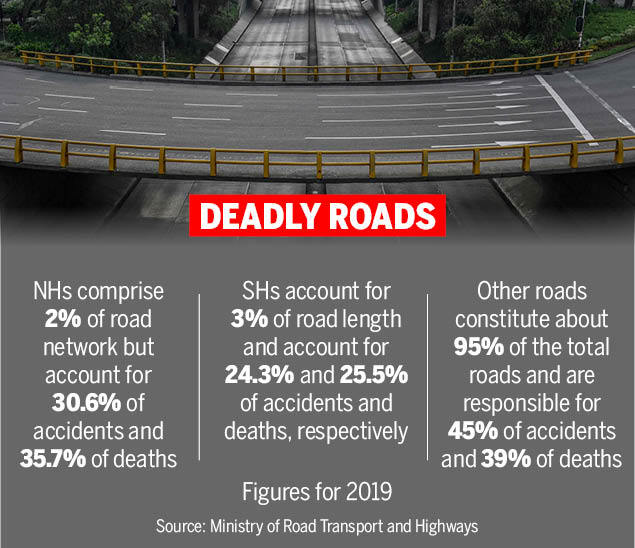
From: Kanishk Sharma, May 30, 2021: The Times of India
India tops the world in road crash deaths. A look at some of the dangerous stretches and why our highways are death traps
- May 5, 2021: Vivek Sharma (name changed) and his wife had a narrow escape when their car hit a nilgai on National Highway (NH)509 near Silhari in Badaun district, Uttar Pradesh
- December 27, 2020: Narayan Beniwal, an MLA from Nagaur district in Rajasthan, suffered serious injuries after his SUV collided with a pickup vehicle near Shahjahanpur on Delhi-Jaipur highway (NH8)
- January 30, 2019: Singer-cum-stage performer Shivani Bhatia was killed when her husband Nikhil lost control of the vehicle on Yamuna Expressway in Mathura district
These three incidents are not even the tip of the iceberg. India reported 92,837 deaths in 2,35,929 road accidents on national and state highways in 2019, according to the Ministry of Road Transport and Highways. This amounts to a fatality rate of around 39.34%.
The World Bank has come out with more damning statistics. In its 2019 report ‘Guide for Road Safety Opportunities and Challenges: Low- and Middle-Income Countries Country Profile’, it says: “India tops the world in road crash deaths and injuries. It has 1% of the world’s vehicles but accounts for 11% of all road crash deaths, witnessing 53 road crashes every hour; killing one person every four minutes.”
India’s road ministry has identified many spots which have witnessed a high number of accidents and deaths. Here’s a list of the most dangerous highway stretches with the highest number of accidents and fatalities:
Chennai–Thiruvallur High Road The 500-metre black spot stretch on Chennai-Thiruvallur High Road between Mannurpet and AMBT Telephone Exchange in Chennai, Tamil Nadu, on NH205 is on the top of the list with the most number of accidents and fatalities between 2016 and 2018.
According to a National Highway Authority of India (NHAI) data, the stretch has seen 775 accidents and 166 fatalities in three years.
NH37 in Assam NH37 connecting Manipur and Assam has a little known stretch between Garchuk and NP School in Guwahati. According to NHAI data, this stretch of the national highway has seen comparatively fewer number of accidents but the fatality count is much higher than other highway stretches. The spot has witnessed just 193 accidents, but a significant 104 deaths between 2016 and 2018.
Three more black spots on the same highway have been marked as dangerous for motorists. The Boragaon to Garchuk stretch saw 81 fatalities in 163 accidents while Baligate-Kapalkata-Samata block saw 76 deaths in 157 mishaps.
Beharbari Chariali to Lalmati stretch witnessed 186 crashes and 64 fatalities.
Nazarathpet junction on Bangalore-Chennai Road The Nazarathpet junction on the Bengaluru-Chennai Road on NH44 in Tamil Nadu’s capital is not far behind in terms of accidents and fatalities. This 500-metre stretch has witnessed 520 crashes and 96 deaths between 2016 and 2018, according to NHAI.
Tambaram-Puzhal Bypass Road near Porur toll gate, Chennai Chennai again features on this list of most deadly black spot stretches on national highways in the country. The Tambaram-Puzhal Bypass Road has witnessed fewer accidents than Nazarathpet junction at 423, but more deaths in three years (97).
Purva Road on NH25 in Uttar Pradesh A stretch in Uttar Pradesh makes it to the list with a fatality rate of 89.61% and has been marked as dangerous. A black spot on Purva Road on NH25 in Unnao district has witnessed 77 accidents and 69 deaths between 2016 and 2018.
Govt JR College Centre, RTC Ingate in Andhra Pradesh This stretch in Andhra Pradesh’s East Godavari district has seen 38 mishaps and 50 deaths between 2016 and 2018 with a fatality rate at 131%.
Karanpur Pahadee on NH7 in Uttar Pradesh As many as 55 people have lost their lives in 74 accidents on a black spot in Karanpur Pahadee area on NH7 in Uttar Pradesh’s Mirzapur district between 2016 and 2018, according to NHAI data.
So, what is a black spot? A black spot is a road corridor of about 500 metres on which five road accidents involving fatalities and serious injuries, or 10 road fatalities, have been reported during the last three years.
Tamil Nadu has the most number of black spots at 748 followed by West Bengal (701), Karnataka (551), Telangana (485) and Andhra Pradesh (466).
Highways to hell Recently, the International Road Federation (IRF), a Geneva-based body, wrote to Union Minister for Road Transport and Highways Nitin Gadkari urging him to circulate the scientific guidelines developed by the Indian Road Congress (IRC) to identify and treat black spots in the country.
In his letter to Gadkari, IRF’s president emeritus KK Kapila said that all counter-measures – short term, medium term and long term – adopted by the field officers assigned to remove black spots are totally ad hoc without any basis of scientific investigation across the country.
“The black spot programme of the government has been going on since 2015, when the first list of black spots was issued by the ministry, and after six years, we have still not been able to make a difference in the country’s road safety outcome in terms of number of accidents/road crashes recorded year on year. One reason perhaps is the ad hoc approach of tackling the blackspots. Lot of efforts and resources were expended without deriving commensurate benefits,” said Kapila.
' Blame it on black spots ‘ “To blame only black spots for the accidents and related deaths is not the correct way to address the real issue,” says Rohit Baluja, director of Institute of Road Traffic Education and College of Traffic Management, Faridabad.
He goes on to say “poor traffic engineering and almost negligible enforcement are amongst the important reasons for highway crashes”. Baluja says: “Vulnerable road users are not given importance. Higher speeds, design failures and negligence of concessionaires and engineering agencies have to share the blame.”
Why are Indian highways unsafe? “Indian highways are unsafe due to mixed traffic conditions. High-speed motor vehicles, unsafe road infrastructure and pedestrian movements contribute to the high accident rate,” says Amar Srivastava, an IIT alumnus, who heads the country’s biggest student-led road safety organisation, Indian Road Safety Campaign.
“Major accidents result in fatalities due to inadequate emergency trauma care facilities and delayed response time. Moreover, the rapidly growing number of vehicles, bad driving skills and weak enforcement of law add to the problem,” he says.
Geetam Tiwari of the Indian Institute of Technology, Delhi and an expert on transport planning and engineering says non-availability of designs for mixed traffic conditions, poor implementation of known design standards for motorised traffic like incorrect safety barriers, wrong median designs make our highways unsafe.
“Also, traffic and crash patterns are substantially different in India. Therefore, highway design standards that are applicable in the US or UK may not have the same level of effectiveness in ensuring safe movement of traffic in low-to-middle-income countries like ours,” she says.
Highways in India generally cater to mixed vehicular population with varying speeds. Drive down an Indian highway and you’ll notice trucks, cars, two wheelers and non-motorised vehicles, including bicycles, camel and bullock carts jostling for space.
The presence of pedestrians from nearby rural areas adds to the problem, says Neha Khullar, director (projects) of Muskaan, a Rajasthan-based non-profit which works on road safety.
“Also, most accidents happen either at crossroads where the highway is passing through a habitat or on straight roads where there are no facilities for speed management,” she says.
“NHAI develops and invests in highways, which bring economic advantage and prosperity for the states through which they pass. What is missing is the responsibility of the states/UTs in contributing to enforcement, protection and use,” says Baluja of the Institute of Road Traffic Education and College of Traffic Management.
Should we blame the drivers? “To blame them alone would be harsh. They are skilled but what is missing is their knowledge about rules, art of defensive driving and respect for the right-of-way of other road users. This is the outcome of getting licences without proper training and assessment,” says Baluja.
Miles to go
On average India sees 4.5 lakh road accidents every year, according to World Bank, in which 1.5 lakh people die. India loses 3.14% of its GDP because of road crashes.
Just constructing highways and linking cities is not enough. Experts feel that authorities, law enforcement agencies, contractors and other associated entities need to do scientific analysis of every highway accident jointly to understand the real reasons behind it. They also need to enforce rules on motorists in a strict manner. Then only can they formulate correct policies, educate drivers and lessen the chances of deadly road crashes.
But that’s a long road ahead.
[edit] The best highways
[edit] 2021
Dipak Dash, March 2, 2021: The Times of India
Ahmedabad-Vadodara section of NH-48 is the best rated national highway in the country followed by the corridor from Goa/Karnataka Border to Kundapur in Karnataka. In the first ever ranking of NH stretches carried out by the NHAI where toll is being collected, 31 out of 219 such stretches have scored more than 80 marks on a scale of 0 to 100.
The scores of all these stretches with a cumulative length of nearly 19,000 km were released by Union road transport and highways minister Nitin Gadkari on Monday. NHAI officials said this was a move to make the key highway construction authority “accountable” to the users who pay for using the NH stretches. PM Narendra Modi in 2019 had asked the highway ministry to rank NH stretches on quality and safety parameters.
While Delhi-Meerut Expressway ranked at 35, the access controlled Delhi-Gurgaon Expressway is at 103. The 63.5 km NH stretch from Delhi/ Haryana Border to Rohtak has received the second lowest score.
The NHAI has included the completed highway and expressway stretches that are of four or six lanes.
[edit] Factoids about National Highways
[edit] Least and most expensive; fastest and slowest to construct
See graphic, ' National Highways: the Least and most expensive; fastest and slowest to construct ' The Times of India,
Dec 20 2014
There were 127 delayed national highway projects as per December, 2014. An analysis of the estimated project cost per kilometre and the rate of construction of these roads showed some interesting patterns. Bridges were understandably far more expensive to construct--the per km cost of construction of Chambal bridge on NH-76 was Rs 200.9cr, 84 times the cost of construction of the Rai Bareli-Allahabad section of NH-24B. They also had the slowest construction rate. The annual construction rate was 0.1 km for the Chambal bridge, far lower than the 123.8 km year rate at which sections of NH-69A and 26B were being constructed.
[edit] 2019: UP vis-à-vis MP
Dipak Dash , Oct 27, 2019: The Times of India
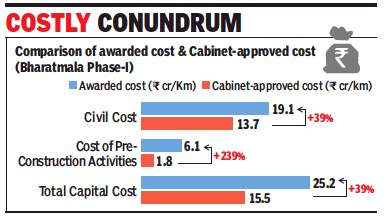
From: Dipak Dash , Oct 27, 2019: The Times of India
High circle rates and varying norms for fixing the rate based on the size of land parcels have made it difficult for the National Highways Authority of India to acquire land for expansion of existing highways in Uttar Pradesh and Madhya Pradesh. While acquiring one hectare of land in these states could cost up to Rs 9.5 crore if the land parcels along the NHs are small, big parcels could cost just Rs 1 crore per hectare.
Citing these discrepancies which have pushed up the compensation amount, the road transport ministry has urged the two states to rationalise circle rates.
This is a big concern particularly in eastern UP in areas such as Ghazipur, Jaunpur and Varanasi where circle rates of small land parcels (less than 500 sq m) are close to Rs 2.4 crore. As per the land acquisition law, the NHAI needs to pay compensation which is four times of the circle rate in rural areas.
But, if the land parcel is larger than 500 sq m, the circle rate is close to Rs 24 lakh per hectare. “So, there is almost a 10-fold difference in the circle rates for two types of land parcels. Ideally, circle rates should be fixed taking into account the price at which properties were sold recently. We have suggested the states to have one circle rate for one region,” said an official. Besides the arbitrary increase in circle rates, the states are also charging huge amounts for shifting of utilities such as water and gas pipelines and electricity lines. Recently, last NHAI chairman N N Sinha had flagged these issues in a meeting with state government representatives.
How high land costs and hefty charges for shifting utilities have hit the viability of projects is evident from the latest NHAI data. This shows that, in the past two years, while the civil construction cost of highway projects under the Bharatmala scheme increased by 40%, the cost of pre-construction activities increased by 240%. Pre-construction activities include land acquisition and shifting of utilities.
According to an estimate, the NHAI will require about Rs 9.2 lakh crore for the 25,000-km Bharatmala scheme against the approved budget of Rs 5.5 lakh crore.
Meanwhile, the NHAI has decided to take up only viable projects which have more than 6.8% internal rate of return. Sources said the highways authority has chalked out plans to award about 3,600km during this financial year and efforts would be made to push the award of another 1,800km.
For non-viable projects, the NHAI will seek funds from the road transport ministry.
[edit] Finances
[edit]
The Times of India, Apr 18 2016
Centre cuts NHAI's share of fuel cess
Dipak Dash
National Highways Authority of India (NHAI) may now have to fend for itself. The road transport and highways ministry has told the authority that it will provide only Rs 2,000 crore as its share of fuel cess this year compared to last year's Rs 15,000 crore.
NHAI requires about Rs 65,000 to Rs 70,000 crore for the current financial year. Its sources of revenue are cess and toll charges, which put together will be around Rs 10,000 this year. It will now have to raise the remaining money from the market through tax free bonds.
While the ministry told NHAI that it needed more from the budgetary support (cess) to fund highway development projects which it implements through state PWDs and NHIDCL, the highway authority has protested saying this allocation was unsustainable.
NHAI's share from the fuel cess allocated to the ministry has been increasing since it was levied for the first time in 1999.During 2015-16, it was all time high at around Rs 15,000 crore from the total allocation of Rs 23,000 crore for the highway sector. In 2015-16, the total allocation of cess to the ministry has been increased to Rs 42,000 crore. The authority was expecting to get about Rs 25,000 crore from this fund.
Sources said the highway authority had raised Rs 23,000 crore as tax free bonds to meet expenses last year.
“We have been able to raise so much as our tax free bonds are rated as AAA. This rating is because of assured fund flow to NHAI in the form of fuel cess from government and the toll revenue that we receive. This year we may be able to raise the desi red amount, but what will happen next year or the year after that?“ asked an NHAI official.
In fact, while rating the NHAI bonds, rating agencies have always highlighted how fuel cess remains the major source of the authority's finances.
In a recent communication to the highways ministry, NHAI also referred to the B K Chaturvedi committee report of November 2009 which mentioned that finance ministry should issue a letter of comfort to NHAI assuring that the fuel cess for building highways by the agency would be continued till 2030-31 for sustainable financing. In fact, the highway ministry had given in-principle approval to NHAI for providing letter of comfort, confirming availability of cess at least till 2030-31.
The National Highways Authority of India needs more funds since it is involved in widening of highways to four and six lanes and needs to acquire land for such expansion.
On the other hand, projects implemented by the ministry don't require land acquisition as most of these are widened to two-and-a-half lanes.
Moreover, with private investment still coming less the sector, NHAI has to execute most of the projects will 100% government fund.
[edit] 2018: Private banks lead in funding
Dipak Dash, December 25, 2018: The Times of India
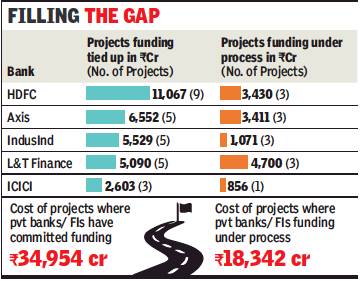
From: Dipak Dash, December 25, 2018: The Times of India
Private sector lenders such as HDFC Bank, Axis Bank, ICICI Bank, IndusInd, L&T Finance, Kotak Mahindra, RBL and Standard Chartered have come forward to fund highway projects in a major way as stressed public sector banks remain shy of providing finance to the sector.
Data collated by government showed private sector players have stepped in to provide loan for over half of the 59 projects where construction companies have tied up funds. Similarly, they have committed to provide funds for 17 out of the 20 projects where the process of financial closure is under way.
“There is a huge jump in private sector banks and FIs funding projects this year as compared to last year and it’s highest ever in NHAI’s history. Banks face no risk in these projects implemented on an Hybrid Annuity Model (HAM). One of the reasons behind the interest of private banks in the sector is the RBI imposing prompt corrective action (PCA) on 11 banks. Public sector banks have also been facing the problem of excess credit exposure,” an NHAI official said.
Unlike Build-Operate-Transfer (BOT) mode where the private player is tasked with toll collection for certain years to recover investment and clear bank dues, in case of HAM, toll collection is NHAI’s responsibility and hence there is hardly any risk. “The only risk is during the construction phase. To ensure that project does not get stuck, we preferred to get land and clearances before giving letter of appointment to start work. Unlike in BOTToll where construction companies and banks had faced problems after the work started, we have taken steps to avoid such a situation,” said an official at NHAI.
[edit] Land issues
[edit] Cost of acquiring land
The Times of India, July 27, 2015

Land cost per km Rs 4.5cr, up from Rs 75 lakh in 2011-12
The land acquisition law enacted during UPA's tenure has pushed up the cost of buying land for highway projects almost six times over five years. In the financial year 2014-15, the National Highways Authority of India (NHAI) estimates the initial price per hectare at Rs 3 crore, compared to Rs 56 lakh in 2011-12. Compared to the average cost of Rs 1.35 crore a hectare during 2013-14, the acquisition value is estimated to be more than double this year. This has resulted in the overall cost of constructing a kilometre of a four-lane highway rising to almost Rs 16 crore, compared to Rs 11crore -12 crore a couple of years ago. A steep rise in the project cost has implications for the toll users pay.
The overall cost of building a kilometre of road includes construction expens es and the compensation paid during land acquisition. Sources said the expenditure towards land acquisition for building bypasses could be even higher -as much as Rs 10 crore-11 crore a hectare in certain parts of the country -as land around urban clusters is more valuable. Also, it bypasses need for more land compared to upgrading an existing two-lane stretch to four lanes. The higher cost of land has implications for the greenfield expressways planned around the country .
Land was around 10% of the cost for constructing a four-lane highway in 2011-12, compared to almost 45% now. For instance, to build a kilometer of a four-lane highway , around 1.5 hectare is needed, which would have cost around 75 lakh in 201112. Now, the acquisition cost has increased to around Rs 4.50 crore for a km, in addition to the construction cost. But officials concede that thanks to higher compensation, landowners are willing to offer land for acquisition, after provisions of the new land law became applicable for NH projects from January . But the ministry has sought relaxations under the current law arguing that acquisition for linear projects does not displace people in large numbers unlike projects for irrigation.
[edit] Farmers can turn land along NHs into `highway nests'
NHAI Will Let Them Change Land Use From `Agri' To `Commercial'
Farmers owning 2-5 acres along national highways can develop these land parcels into a `highway nest' or `highway village' with prescribed services ranging from quality food to clean toilets and comfortable resting facilities for travellers. NHAI will allow access to these facilities from highways and help land owners get the land use changed from `agriculture' to `commercial' category.
“We will only be a facilitator. NHAI will pursue the case for setting up of fuel stations at these locations.These facilities will get the NHAI brand name and will have to comply with the service-level benchmark. We are not charging anything from them,“ highways minister Nitin Gadkari said on Thursday while launching the initiative to make farmland owners a part of the highway success story .
These facilities will come up every 40 km. NHAI targets to set up 700-800 such facilities in the next one and a half years. Unlike western countries, most of the highway stretches in India lack good amenities for commuters. Gadkari said tourists have a harrowing experience when they don't find a good resting place even on tourist circuits.
NHAI chairman Deepak Kumar said they have floated tenders for similar facilities where land is available with NHAI. The authority will set up 200 such facilities along NHs on franchise model and these will be operational in the next one year, he said.
Highways secretary Y S Malik said the new facilities will offer an additional option to commuters to the existing `dhabas'. “Only 30% of the land parcel will have construction and the rest will be circulation areas.People can park their vehicle comfortably and take a break,“ he said.
Interested farmers will have to give the option based on the size of land. NHAI will chose land parcels which have more frontage areas on the NH. “The land owners have to invest and NHAI won't be involved in any manner,“ an official said.
The NHAI chief said bigger land parcels will be qualified for highway village, which will have more facilities including rooms for short stay for passengers and dormitories for drivers, minor workshops for repair and village haat. Smaller plots will get the tag of `nest' with relatively less facilities.
[edit] Length of roads (+ road construction, expansion)
[edit] 1990-2013
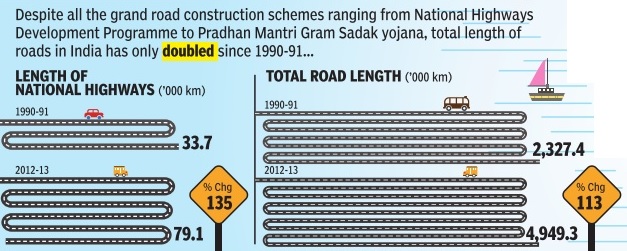
Graphic courtesy: The Times of India, March 2, 2016
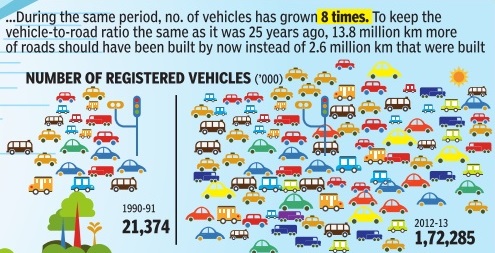
Graphic courtesy: The Times of India, March 2, 2016
See graphics,
'Length of National Highways and total road length, 1990-2013 '
and
‘Number of registered vehicles, 1990-13’
[edit] 1990-2015
See graphic, ' Growth of national highways, 1990-2015 '
[edit] 2000- 2015
See graphic, ‘Length of roads added between 2000 and 2015’
[edit] 2008-2015
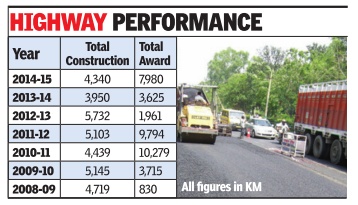
Graphic courtesy: The Times of India
See graphic, ' Highways performance: total construction and total award, year-wise; 2008-2015'
[edit] 2008-2016
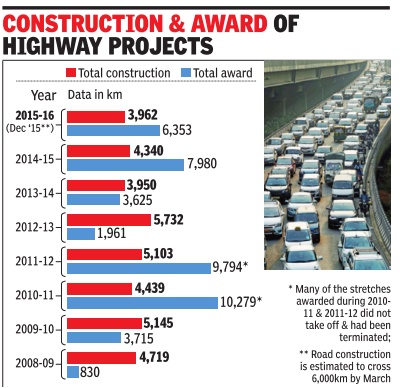
Graphic courtesy: The Times of India Jan 10 2016
See graphic, ' Construction and award of highway projects: 2008-16 '
[edit] 2009-14 vis-à-vis 2014-18
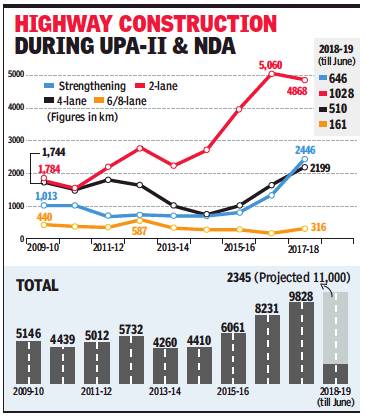
From: Dipak Dash, NDA pips UPA-II in building roads, but most are 2 lanes, October 8, 2018: The Times of India
‘Construction Of NH To Touch 39,000km By March-End’
Construction of national highways (NHs) in NDA’s over four-year rule has risen by 26% at 31,000 km compared to UPA-2’s 24,425 km in five years. However, under both the governments, most of the work was linked to strengthening and widening of existing highways to two lanes.
Highway ministry officials said the construction figure for NDA’s full term would touch at least 39,000 km by March-end, which would be a 60% rise over the 2009-2014 tally. While the share of strengthening of existing highways and widening of NHs to two-and-ahalf lanes (two lanes plus paved shoulder) during NDA was about 76% of the total highway development work, it was nearly 60% during UPA-2.
Strengthening of road involves dense carpeting and other treatment of identified stretches after assessing the deficiencies. In this case, the existing road is not widened but is improved to handle increased traffic load for the next 5-10 years. Under the two-laning programme, narrow roads are widened to at least two lanes with paved shoulder. As of now, nearly 75% of the 1.3 lakh km NH network in India is either of two lanes or less.
Government data showed that during UPA-2, about 16,650 km out of the total 24,455 km constructed fell under the strengthening and two-laning categories. During NDA rule, strengthening and two-laning put together had a share of about 23,570 km out of the approximately 31,000 km built till June-end.
“We had the highest ever record of building four-lane highways in 2017-18 at 2,200 km and this year, it will be more than 3,000 km. Fourlaning of highways had slowed down during the first two years of this government as there was a sudden withdrawal of highway builders, who had bagged projects under public private partnership during the earlier government. The land acquisition law also created problems. We had to find solutions to revive the sector and accelerate the construction,” a government official said.
National Highways Authority of India (NHAI) primarily widens NHs to four lanes while the road transport ministry executes strengthening and two-laning of highways through state public works departments. Officials said twolane highways were enough to meet the requirement in hilly states while even in the plains, such roads in good condition could cater to 15,000 vehicles a day.
For long, there has been a debate whether NHs should be of at least four lanes to give them a different identity from other roads. However, due to increased political demand to convert more and more roads into NHs, about three-fourths of the NH network are still either of two lanes or less.
[edit] 2014-18: the Top 5 states
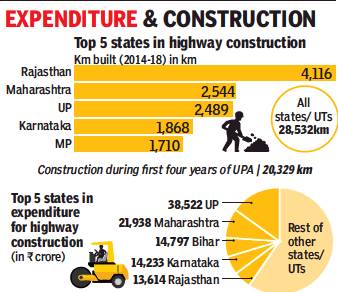
From: Dipak Dash, NH construction fastest in Raj in last 4 years: Data, January 14, 2019: The Times of India
Rajasthan reported the highest national highway (NH) construction among states during the first four years of the Narendra Modi government while Centre’s expenditure was maximum in Uttar Pradesh for building highways. Acording to government data, Maharashtra ranked second both in highway construction and expenditure between 2014-15 and 2017-18.
According to the details available with TOI, the NH construction and widening during the current NDA government stood little over 28,500 km till March 2018, which was about 40% more than what the UPA had built between 2009-10 and 2012-13. Highway ministry officials said the gap will be bigger when the current financial year ends in March. The pace of construction has increased substantially during the past three years and this year they hope to achieve building at least 11,000 km. Till December end, the overall construction figure was approximately Rs 6,700 km.
[edit] 2016: No. of lanes, road length
Dipak Dash, 78% of national highways have only one or two lanes, Oct 17 2016 : The Times of India
40% Of Roads In India Not Metalled: Data
In a stark indication of how far India has to go in developing its highway network, latest official statistics reveal that around 78% of national highways are either one or two-lane affairs. One third are less than two lanes, making the task of four-laning India's economic lifelines a challenging endeavour.
A report of the road trans port and highways ministry also shows that nearly 40%, including rural, intra-district and state highways, are not metalled -outlining the limitations in connectivity but al so offering hope that road development in remote areas can be a major employment generator for many years to come.
According to the report, just five states -Maharash tra, UP, Karnataka, West Bengal and Assam -account for 43% of the road network.The implications are obvious as fixing the imbalance can be key to literally speeding up India's economy through smoother freight movement.
Over 14 lakh km of road is yet to be surfaced, over 11.5 lakh km being rural and project roads. While rural roads include stretches owned by panchayats and zila parishads in addition to networks under Pradhan Mantri Gram Sadak Yojna, project roads cover stretches built by the forest, irrigation and electricity departments, among others. Road length in India incre ased from 33.73 lakh km in 2000-01to 54.72 lakh km in 2015 and rural roads account for the maximum share of 61% of the entire network. State and national highways, which carry over 60% traffic, have less than 5% share. These are even less than the country's total urban road network.
A comparative analysis of the report also shows that Assam has the maximum length of non-metalled or unsurfaced roads (nearly 2.67 lakh km) followed by 1.85 lakh km in West Bengal and Maharashtra. Interestingly , Delhi, which ranks fourth in the list of states with maximum urban roads, has nearly 8,700km of non-metalled stretches.
Road transport ministry officials said considering that road development works have a multiplier effect on the economy and job generation, highways minister Nitin Gadkari has given an in-principle approval to increase the length of national highways from 1.05 lakh km to 1.40 lakh km. In fact, the ministry has also revised the norm for qualifying highway stretches for their widening from two lanes to four lanes. Moreover, the ministry has set a target to wi den all national highways to at least two lanes.
“National highways mu st be of some standard so that people can find the difference the minute they take NHs.
Simple notification to declare state highways as NHs may have political significance, but the real task lies in expan ding and improving them,“ said S P Singh of IFTRT, a Delhi-based thinktank on transport issues.
[edit] 2015-16: expansion
The Times of India, Sep 12 2015
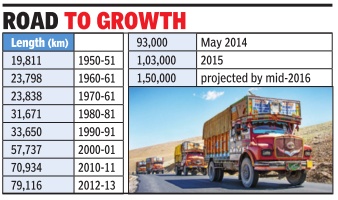
Dipak Dash
National highways to grow by 50,000km in 6 mths
The road transport and highways ministry is supposed to add nearly 50,000 km of roads to the National Highways (NH) network in the country till March 2016. This addition within two years of the Narendra Modi government will be more than twice the length NDA-I had added in its six years and over three times of what UPA added in its 10-year rule.
Sources said Between June 2014 and August 2015, the new government has added about 7,000 km of roads to the NH length and at present it's little more than one lakh km. Road transport and highways minister Nitin Gadkari has announced to take it to 1.5 lakh km by this year end.
Between 1998 and 2004 when NDA was in power, about 23,814 km was added to the NH network and during the 10-year rule of the UPA government, a total of around 18,000 km were designated as NH.
On how the ministry is now going about including more stretches as NH, an official said, “While process of notification to include about 15,000 km under Bharat Mala and joining backward areas in the NH network is under way , we are carrying out feasibility study for large chunk of stretches that states have forwarded for upgrading them as NHs. This would be about 20,000 km.“
Sources said adding length is crucial to maintain the pace of award, which has been increased to about 30 km a day . Putting its focus to accelerate highway construction as growth multiplier, the Modi government plans to continue this high target of award of works for 3-4 years. “Moreover, ideally most of the major roads connecting districts, upcoming business hubs and even religious and tourist places should be connected with at least two-and-half lane roads,“ an official said.
However, there is also a flip side to it. Converting more stretches of state highways or major district roads to NHs will increase burden on the Central budget as states will stop spending on maintenance of these stretches as soon as the corridors are notified as NHs.Some of the officials said the situation won't get out of government control as most of the stretches being expanded now are on a model named “EPC contracts“. Under this, the contractor has to maintain the road for one year and is also responsible for any defect for four years.
[edit] 2015-16: Record construction
The Times of India, Apr 11 2016
In 2015-16, record 6,029 km of highways constructed
Dipak Dash
The construction of highways touched an all-time high of 6,029 km during 2015-16.Prior to this, a maximum of 5,732 km of national highway was constructed during 2012-13.
Officials said while NHAI reported construction of nearly 2,000 km, the rest came from works done by the road transport ministry through its agencies including state public works departments, Border Roads Organisation and ministry's entity NHIDCL for undertaking works in hill states.
TOI on January 10 had first reported how the total construction was set to cross 6,000-km mark.
Though surpassing 2012-13 record by merely constructing one extra km per day may not be that big achievement, sources said the increased pace of construction will now continue for the next few years.
[edit] 2015-16: 360km added daily
India’s road length increased by 1.31 lakh kilometres within a span of one year between March 2015 and March 2016, according to the latest report released by the road transport and highways ministry. This translates to adding 360 km daily to the country’s road network in comparison to 170 km and 190 km per day in 2013-14 and 2014-15 respectively.
India’s road network increased from 54.72 lakh kms to 56.03 lakh kms on the back of higher pace of construction of rural roads which pushed up the total length by almost half. Not just length, even quality improvement was reported in the national highway (NH) segment with more number of one lane stretches getting converted to minimum two lanes. The share of less than two-lane roads reduced by 10% during 2015-16, while the share of two-lane roads increased by little over 8% and another 3% increase in the share of NHs that are of four lanes or more.
The increased effort to build and widen more NHs is also evident from the rising expenditure in the highways sector. According to the “Basic Road Statistics of India 2015-16”, the total expenditure — both public and private — was Rs 98,900 crore during 2015-16 in comparison to Rs 54,935 crore during the previous financial year, a whopping 55% increase.
However, large chunk of unpaved road network remains a concern as still 38% of the entire road network across the country is yet to be surfaced and most of these are rural roads. Among all the states Assam has the worst record with only one-fifth of its road network surfaced. This provides a huge opportunity for both the state and central governments to push road building in rural areas to generate employment.
[edit] 2017: 23% increase
Dipak Dash, Pace of highway building increased by 23% in 2017, December 25, 2017: The Times of India
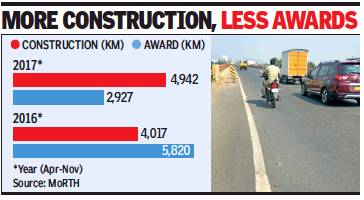
From: Dipak Dash, Pace of highway building increased by 23% in 2017, December 25, 2017: The Times of India
The pace of national highway construction during April-November 2017 increased by 23% over the same period in 2016. Officials said they were confident of crossing 9,000 km this fiscal to register the highest ever construction of highways, though it will be way less than the ambitious target set by the highways minister at 40 km per day.
Last year, 8,231 km of highways were constructed, which is the highest in a single fiscal so far.
According to data compiled by the road transport and highways ministry, construction and widening of 4,942 km was completed by November 30, which is about 20.5 km a day. During the same period in the last financial year, construction stood at 4,017 km and the average daily construction was 16.7 km.
“December to March are the most favourable months for road construction across the country. Usually, construction achieved during these months is equivalent to the total building of roads in the first eight months of any financial year.
“We are holding regular reviews and progress is monitored keenly for faster completion of stretches under construction,” a ministry official said.
While increased pace of construction is a positive indicator, the highways ministry is concerned over the fall in award of projects during the first four months of this financial year. Between April and November, work for only 2,927 km was awarded, which is about half of the stretches awarded during the same period in 2016-17.
Ministry officials said NHAI, which has been slow in awarding contracts this year, has floated a large number of tenders and has assured the government that it will meet the target of awarding works for 10,000 km by the end of March.
[edit] 2017-18: The Top 5 states

From: September 28, 2018: The Times of India
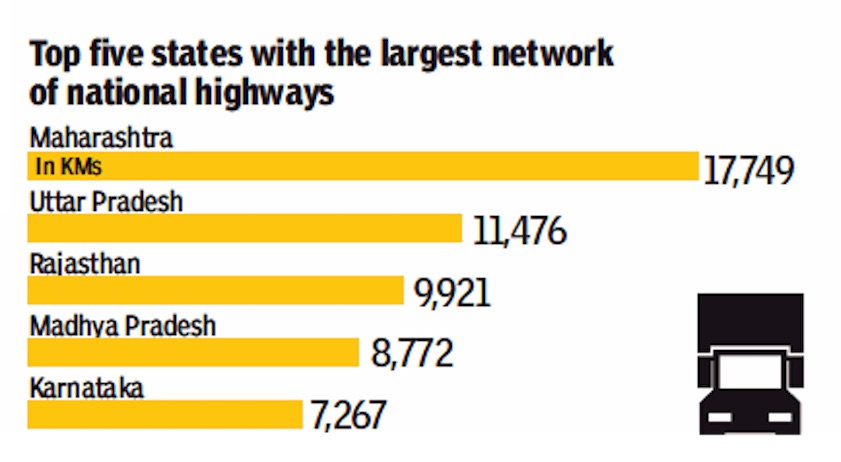
From: September 28, 2018: The Times of India
See graphics:
The top five states in National Highways construction, 2017-18
The Top 5 states in terms of a network of national highways- 2017-18
[edit] Maintenance issues
[edit] 23 NH bridges, tunnels over 100 yrs old
Dipak Dash|23 NH bridges, tunnels over 100 yrs old|Jul 04 2017 : The Times of India (Delhi)
New Delhi:
17 Of Them Need Major Maintenance, 6,000 Other Bridges Also Safety Hazard
Twenty-three bridges and tunnels on national highways (NHs) are over 100 years old, of which 17 require rehabilitation or major maintenance. As many as 123 other bridges in the country require immediate attention and 6,000 are structurally “distressed“. These are some of the findings of a analysis conducted by the Union road transport and highways ministry under its Indian Bridge Management System (IBMS) project, India's firstever survey of the “health of bridges“, launched last year.
The over-a-century-old structures include the Narmada bridge in Bharuch, Gujarat; two at Tikamgarh in Madhya Pradesh; and one each at Gulbarga in Karnataka, and Kolhapur and Pimri Chinchwad in Maharashtra.All of these need rehabilitation or major maintenance. After the study, the minis try has found there are about 1.6 lakh structures, including culverts, minor and major bridges and flyovers on India's NH network. Each of the structures has now got a unique identity number under this initiative, and undergo periodic inspection.
Sources said highways minister Nitin Gadkari has asked the ministry , the National Highways Authority of India (NHAI) and the state public works departments, which manage NH stretches, to undertake immediate repair or rehabilitation work on structures that require immediate attention. “He has also instructed that we should go for rehabilitation of the bridges if the cost of repair or strengthening is more than 30% of the cost of the bridge,“ a ministry official said.
Gadkari has also directed the entity dealing with the IBMS to install sensors on bridges on stretches that are largely used for movement of over-dimensional vehicles to carry heavy equipment such as electricity turbine, so that the “health“ of these structures can be assessed in real time.
The highways ministry had rolled out IBMS in early 2016 after realising that there was no centralised list of bridges, and hence it depended on physical reports to undertake repair, maintenance or rehabilitation.
“The need to have this web-based system was felt so that we can take the decision for repair, rehabilitation or dismantling of the structures in advance. The collapse of a bridge or complete closure disrupts the traffic flow on a highway stretch, and these have a ripple effect on other stretches as well,“ said a ministry official.
[edit] Speed limits
[edit] 100 kmph on NHs, 120 kmph on expressways
Dipak Dash, 100 kmph speed limit for cars on NHs cleared, February 8, 2018: The Times of India
The highways ministry has approved increasing the speed limit of cars plying on national highways from the existing 80 kmph to 100 kmph. On expressways, the maximum permissible limit for cars will be 120 kmph.
Sources said road transport minister Nitin Gadkari approved the maximum speed limits on Wednesday and a notification will be out soon.
Two-wheelers will be allowed to ply at a maximum speed of 80 kmph on highways and expressways; 90 kmph for trucks and buses on expressway and 80 kmph on national highways.
[edit] 2018/ Maximum speed limit for expressways increased
Govt increases maximum speed limit for expressways, April 14, 2018: The Times of India
The road transport ministry notified the increased maximum speed limit on urban road to 70 kmph while 120 kmph is the new cap for vehicles plying on expressways. The government order came just three weeks before the first expressway built by the Central government around Delhi is scheduled for opening. Till now 50 kmph was the maximum speed limit on urban areas and there was no separate speed norm for expressways.
[edit] Part II: The ministry's overview
This section has been sourced from an authoritative, official After the formal launch of their online archival encyclopædia, |
The source of this section
INDIA 2012
A REFERENCE ANNUAL
Compiled by
RESEARCH, REFERENCE AND TRAINING DIVISION
PUBLICATIONS DIVISION
MINISTRY OF INFORMATION AND BROADCASTING
GOVERNMENT OF INDIA
LIST OF STATE-WISE NATIONAL HIGHWAYS IN THE COUNTRY8
Sl. Name of State National Highway No. Total Length
No. (in km)
1 Andhra Pradesh 4, 5, 7, 9, 16, 18, 43, 63, 202, 205, 214, 214A, 219, 221 & 222 4472
2 Arunachal Pradesh 52, 52A & 153 392
3 Assam 31, 31B, 31C, 36, 37, 37A, 38, 39, 44, 51, 52, 52A, 2836 52B, 53, 54, 61, 62,151,152,153 &154
4 Bihar 2, 2C, 19, 28, 28A, 28B, 30, 30A, 31, 57, 57A, 77, 80, 81, 82, 3642 83, 84, 85, 98, 99, 101, 102, 103, 104, 105, 106, 107 & 110
5 Chandigarh 21 24
6 Chhattisgarh 6, 12A, 16, 43, 78, 111, 200,202, 211, 216 and 217 2184
7 Delhi 1, 2, 8, 10 & 24 72
8 Goa 4A, 17, 17A & 17B 269
9 Gujarat NE-I, 6, 8, 8A, 8B, 8C, 8D, 8E, 14, 15, 59, 113 & 228 3245
10 Haryana 1, 2, 8, 10, 21A, 22, 64, 65, 71, 71A, 71B, 72, 73, 73A , 1512 & NE-II
11 Himachal Pradesh 1A, 20, 21, 21A, 22, 70, 72, 73A & 88 1208
12 Jammu & Kashmir 1A, 1B, 1C &1D 1245
13 Jharkhand 2, 6, 23, 31, 32, 33, 75, 78, 80, 98, 99 & 100 1805
14 Karnataka 4, 4A, 7, 9, 13, 17, 48, 63, 67, 206, 207,209, 212 & 218 3843
15 Kerala 17, 47, 47A, 47C, 49, 208, 212, 213, & 220 1457
16 Madhya Pradesh 3, 7, 12, 12A, 25, 26, 26A, 27, 59, 59A, 69, 75, 76, 78, 86 & 92 4670
17 Maharashtra 3, 4, 4B, 4C, 6, 7, 8, 9, 13, 16, 17, 50, 69, 204, 211 & 222 4176
18 Manipur 39, 53, 150 & 155 959
19 Meghalaya 40, 44, 51 & 62 810
20 Mizoram 44A, 54, 54A, 54B, 150 & 154 927
21 Nagaland 36, 39, 61, 150 & 155 494
22 Orissa 5, 5A, 6, 23, 42, 43, 60, 75, 200, 201, 203, 203A, 215, 3704 217 & 224
23 Puducherry 45A & 66 53
24 Punjab 1, 1A, 10, 15, 20, 21, 22, 64, 70, 71, 72 & 95 1557
25 Rajasthan 3, 8, 11, 11A, 11B, 11C, 12, 14, 15, 65, 71B, 76, 79, 79A, 89, 5585 90, 112, 113, 114 & 116
26 Sikkim 31A 62
27 Tamilnadu 4, 5, 7, 7A, 45, 45A, 45B, 45C, 46, 47, 47B, 49, 66, 67, 4462 68, 205, 207, 208, 209, 210, 219, 220, 226 & 227
28 Tripura 44 & 44A 400
29 Uttar Pradesh 2, 2A, 3, 7, 11, 12A, 19, 24, 24A, 24B, 25, 25A, 26, 27, 28, 28B, 5874 28C, 29, 56, 56A, 56B, 58, 72A, 73, 74, 75, 76, 86, 87, 91, 91A, 92, 93 ,96, 97 , 119 & NE-II
30 Uttarakhand 58, 72, 72A, 73, 74, 87, 94, 108, 109, 121, 123 & 125 1991
31 West Bengal 2, 2B, 6, 31, 31A, 31C, 31D, 32, 34, 35, 41, 55, 60, 60A, 2524 80, 81 &117
32 Andaman & 223 300 Nicobar
Total 66754
Source : Ministry of Road Transport and Highways Website http:/morth.nic.in/ statedetailsmain.asp
